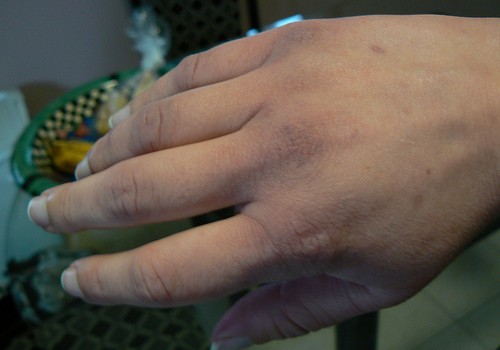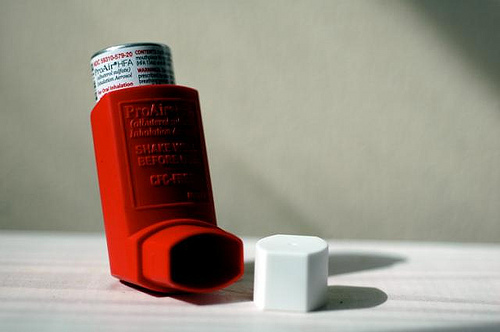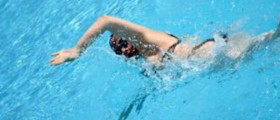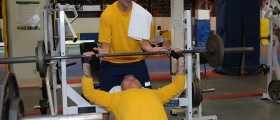
Swimming is One of the Most Effective, Safest and Most Accessible Ways to Exercise
Swimming can be a lot of things to a lot of people. For every one of us who participates in the sport of swimming, there are dozens who like to splash around in the shallow end or play in the pool - or jump off the high diving board! Being able to do the two most basic standard swimming strokes - front crawl and breast stroke - and having a pool near you means having access to one of the simplest and most effective methods of exercise there is, excellent for weight control and general fitness, good for endurance and offering some strength gains too.
- Important notification about information and brand names used in this slideshow!
- Photo courtesy of simon thomas by Flickr : www.flickr.com/photos/simthom/188128237/
- en.wikipedia.org/wiki/Swimming_(sport)

Swimming Can Help Bring Cholesterol Under Control
Swimming can make great improvements to your cholesterol levels. David H. Stone, M.D., member of the Society for Vascular Surgery, calls it a 'vascular health bonanza,' and regular aerobic exercise can both reduce the risk of a heart attack and alter the balance between LDL and HDL cholesterol (note: HDL is the one you want!). While any regular aerobic exercise will have this effect, a study by Bagheri et al found that the effect was more pronounced for swimming than for other aerobic exercise, including running and cycling. Swimming looks like a great way to handle a cholesterol problem - or to prevent one!
- Important notification about information and brand names used in this slideshow!
- Photo courtesy of eric molina by Flickr : www.flickr.com/photos/iamagenious/770199187/
- www.thirdage.com/womens-health/8-health-benefits-of-swimming?utm_hp_ref=fifty&ir=Fifty
- http://www.krcrtv.com/Swimming-can-lower-your-cholesterol-blood-pressure/-/14285892/14460398/-/pamm4i/-/index.html

Swimming Lowers the Risk of Diabetes, Increasing Insulin Sensitivity
Swimming involves moderate demands on both cardivascular and muscular endurance, together with its requirements on the insulin system. It's a great way to lower the risk of diabetes. Burning 500 calories a week in aerobic exercise, men in one study saw their risk of developing diabetes fall by 6%. But swimming breast stroke for thirty minutes, three times a week would mean burning 900 calories by aerobic exercise, meaning that your likelihood of getting diabetes would fall further. And if you already have pre-diabetic symptoms or you have the disease itself, swimming can help massively in improving glycaemic control.
- Important notification about information and brand names used in this slideshow!
- Photo courtesy of Manchester City Library by Flickr : www.flickr.com/photos/manchesterlibrary/3013438314/

Swimming Relaxes the Mind and Body
Swimming is relaxing. On its own, that statement doesn't really seem like a good enough reason to fit an activity into an already full and hectic day - but actually it's the best possible reason. When your attention is pulled here and there, you're run ragged trying to do a dozen things at once and you're tired and tense, relaxing for half an hour could make the rest of your day that much more productive. Relaxing helps you concentrate -and it can be great for your physical health too. Swimming is particularly good for this as the rhythmic contraction and relaxation of the muscles produces a 'relaxation response,' just as yoga does.
- Important notification about information and brand names used in this slideshow!
- Photo courtesy of Alison Curtis by Flickr : www.flickr.com/photos/alisonlongrigg/3472979504/

Swimming Can Prolong Your Life, Adding Active Years to Your Time
Swimming can help you live longer. Dr. Steven Blair carried out a study into the death rates of swimmers, as against those of other cardio athletes like runners. Testing male athletes between 20 and 90 years old over a 13-year period to observe their mortality rates, Dr. Blair found that runners had a 6.6% mortality rate, while walkers had a 7.8% mortality rate. And swimmers? 1.1%, the lowest rate by far. No-one knows exactly why this is, and Dr Blair is first to admit that his study was far too smal to be conclusive, but what indications there are seem to show swimming being the most longevity-inducing of the common aerobic exercise systems.

Swimming is Uniquely Placed to Ease Arthritic Pains
One of the most effective ways to control the pain and discomfort of arthritis - as well as to keep the disease itself under control - is to exercise. But many people with the disease find even moving around normally too painful. Most exercise programmes are right out - but swimming can help. When you're submerged in water, the water takes the weight of your body, meaning that the pressure on your knees and hips is relieved. Being entirely submerged, up to the neck, reduces the 'weight' of your body by 90%. This explains the popularity of water-walking, aquacise and other forms of non-swimming water-based exercise for the elderly or for those with damaged joints. Meanwhile, swimming itself can offer flexibility and strength advantages after a basic level of fitness has been achieved.
- Important notification about information and brand names used in this slideshow!
- Photo courtesy of shoe the Linux Librarian by Flickr : www.flickr.com/photos/linuxlibrarian/3193761687/

Swimming Improves Muscular Strength and Corrects Imbalances
Muscular strength is the ability of a muscle to exert force. Muscular tone is the length the muscle stays at when it's at rest - the 'tonus.' Slack muscles are referred to as 'hypotonic' (lacking tonus), while permanently tight muscles are referred to as 'hypertonic' (too much tonus). Ideally, the tonus of a muscle should let it help with the job of keeping your body the right shape, while allowing you to move freely and feel relaxed. Swimming can be an ideal way to reset the tonus of over-tight or over-loose muscles by repetitive contractions and relaxations - the same effect you'd get from T'ai Chi or yoga, but with the added advantage of a better strength workout than you'll often get from those disciplines.
- Important notification about information and brand names used in this slideshow!
- Photo courtesy of Stuart Boreham by Flickr : www.flickr.com/photos/kagey_b/29081726/

Building Mobility and Flexibility? Swimming Should Be Part of Your Training
Swimming can aid flexibility by using a large natural range of motion with constant resistance. Gradually, you'll find front crawl making your shoulders freer, breast stroke making your legs and hips looser and more relaxed. While for many of us, swimming will only make us slightly more flexible, beginners to exercise, the injured or older people may find that swimming makes radical changes to their flexibility. While swimming doesn't require a very wide degree of flexibility the demands it does make are loaded all the way through, increasing 'active flexibility' - the range of motion where you can actually use a limb rather than just put it there. The protection this offers against slips and falls, pulled muscles and other small everyday injuries is a great benefit for older people.
- Important notification about information and brand names used in this slideshow!
- Photo courtesy of University of Nottingham by Flickr : www.flickr.com/photos/uonottingham/5471495152/

Lose Weight By Swimming - It's Simpler Than You Think
Swimming can help with weight loss. Its combination of resistance and aerobic demands means that it burns calories faster than cardio-only training: swimming gently for an hour will burn about 500 calories, while harder efforts can burn up to 700 calories an hour, or more in the case of highly demanding strokes like butterfly. Swimming allows the body to be supported by the water, meaning that you can work harder without risk of damage to the joints, and the potential for working hard in a fairly risk-free environment means swimming is one of the easiest and most effective exercise methods for weight loss.
- Important notification about information and brand names used in this slideshow!
- Photo courtesy of Lisa Creech Bledsoe by Flickr : www.flickr.com/photos/glowbird/5122817783/

Swimming Can Help With Asthma in Adults and Children
Swimming can help asthmatics build stronger breathing muscles and expand their chests and airways. It can also help with exercise-induced asthma, as the warm humid air you're breathing, near the surface of the pool, irritates the airways less than dry air. Karen Pickering MBE, World and Commonwealth Champion swimmer, says, 'I was diagnosed with asthma at the age of 7. My doctor recommended that I take up swimming and despite the fact that I suffer from exercise induced asthma & am sensitive to chlorine, swimming improved my quality of life by strengthening my lungs.' If you have asthma you should always keep an inhaler by the side of the pool and be careful to warm up well.
- Important notification about information and brand names used in this slideshow!
- Photo courtesy of NIAID_Flickr by Flickr : www.flickr.com/photos/niaid/5950870440/
- health.howstuffworks.com/wellness/aging/retirement/10-health-benefits-of-swimming.htm
- http://www.karenpickeringswim.com/swimming-asthma



























Your thoughts on this
Loading...